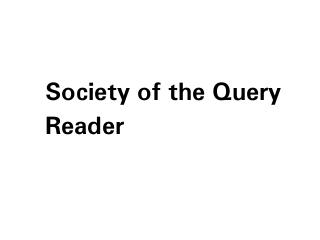Make is a popular free software tool that helps programmers compile their code into programs. Increasingly the tool is finding new uses in publishing workflows to compile prose text into electronic formats like epub and PDF. The INC subgroup has been using make in their hybrid workflow to produce multiple formats of the Society of Query reader. While not a “killer app” with a pretty graphical interface, make represents a distillation of practice that suggests future tools for creating flexible, editable workflows where tweaks and workarounds are the norm.
make software
Make is the name of a software program close to the heart of the Free software movement. When programmer Richard Stallman founded the GNU (Gnu’s Not Unix) project in the 1980s it was in part an effort to reclaim the fruits of his own labour, and this meant rebuilding the essential tools that turn what he writes (computer code) into something usable (a computer program). According to the GNU website:
GNU Make is a tool which controls the generation of executables and other non-source files of a program from the program’s source files.
Free software is distributed as a collection of source files, text files of computer code, that typically need to be compiled into something usable (executable) in a particular situation. In Free software, heterogeneous beast that it is, there is typically no single way to make such a translation happen. And that’s a good thing. Free software is designed to work in a variety of situations of use both technically and socially determined. A software may need to run on different computer hardware or operating systems, and programs often are structured in a modular fashion to allow a user to pick and choose which components she or he needs. As a result, this translation, typically called the build process, can be in programmers parlance, non-trivial.
For this reason, free software has historically been distributed with additional programs, known as a make or build scripts, that make it easier for someone to actually use it. After generations, this practice was itself codified in a piece of software, make, a distillation of the common patterns employed in the writing of these scripts. Using make, the programmer writes a makefile that concisely describes the steps necessary for each piece of the process (known as rules) and how the pieces fit together (known as dependencies). In this process outputs are named, known as targets. Make inherently supports multiple targets allowing a software to be built in a number of ways to produce different outputs. Once the makefile is written, a user just specifies a target and make performs all the steps necessary, in the right order, to produce the result. When source files are edited, make is clever about only performing the steps necessary given what has changed.
make epub; make webpages; make trailer
Crucially make does not itself do anything particular to the compilation of code — the details are left to the specifics of each rule. In this way more like a manager that delegates the “actual” work of making to others. As the phrase other non-source files, obliquely suggests make can in fact be used to produce more than just computer programs. Increasingly, coders have been realizing the value of using make outside of the context of code and started applying it to regular texts. In a recent presentation at a Linux users event, programmer Don Marti described make as an “executable notebook” to create e-books in the epub format in a workflow based on make along with other tools such as git, markdown, and pandoc. In his talk he describes strategies for elegantly incorporating source files in DOCX (Word) format, and managing distributed writing among a team, all without a central server or “CMS”-centric paradigm.
The tools described in Marti’s presentation strongly echo the tools we have been experimenting with in the INC subgroup. We have been using make to produce electronic publications of the Society of the Query reader. In our case a makefile is used to produce a variety of outputs from the same markdown sources: epub, web pages, a GIF-format book trailer, and a (preview) PDF. In addition, we have been investigating how to bridge to a designer producing a layout in a program like InDesign. The latest version of the makefile is posted on the project’s online code repository.

Beyond just supporting multiple outputs from the same sources, what’s really significant about using a make in a publishing workflow is that it makes the various steps of a workflow explicit, including various “workarounds” and patches. By concisely describing all the steps for a particular production, the makefile becomes a legible and crucially editable snapshot of the workflow. Makefiles provide a flexibility and re-editability that means that as the needs of a project change and as tools and formats develop, the workflow remains adaptable. Of course, there are many problems with makefiles: the format, though concise, is technically challenging and often obscure. Also, make is typically used from the command line, a way of working that is alien and intimidating to many non-programmers. Still, the solutions that make offers to a host of non-trivial problems is at the very least suggestive of the kinds of features future tools for hybrid publishing would ideally provide.
Links
- Nathan Willis’ post on LWN, where I originally read out about Marti’s presentation
- Don Marti presentation at SCALE
- Don Marti slides
- GNU Make the official project homepage


